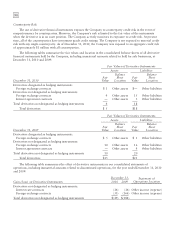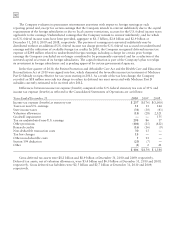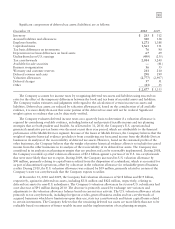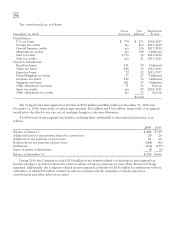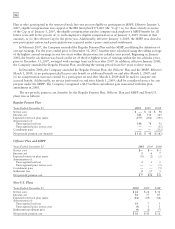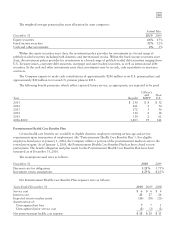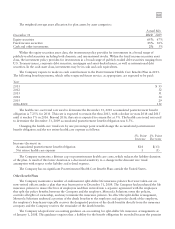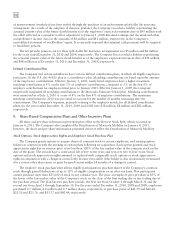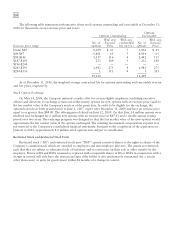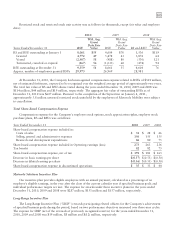Motorola 2010 Annual Report Download - page 106
Download and view the complete annual report
Please find page 106 of the 2010 Motorola annual report below. You can navigate through the pages in the report by either clicking on the pages listed below, or by using the keyword search tool below to find specific information within the annual report.
98
As a result of the Company’s separation into two independent, publicly traded companies, during the three
months ended December 31, 2010, the Company recognized a curtailment gain in one of its Non-U.S. plans,
resulting in the recognition of a gain in the Company’s consolidated statement of operations of $4 million. During
the same period, as a result of legislative changes that were finalized in December 2010, the Company changed the
index used to estimate cost of living increases. As a result, the Company recorded a $55 million gain in
Accumulated other comprehensive loss, net of tax. No gain or loss was recognized in the Company’s consolidated
statement of operations as a result of the amendment.
Certain actuarial assumptions such as the discount rate and the long-term rate of return on plan assets have a
significant effect on the amounts reported for net periodic cost and benefit obligation. The assumed discount rates
reflect the prevailing market rates of a universe of high-quality, non-callable, corporate bonds currently available
that, if the obligation were settled at the measurement date, would provide the necessary future cash flows to pay
the benefit obligation when due. The long-term rates of return on plan assets represents an estimate of long-term
returns on an investment portfolio consisting of a mixture of equities, fixed income, cash and other investments
similar to the actual investment mix. In determining the long-term return on plan assets, the Company considers
long-term rates of return on the asset classes (both historical and forecasted) in which the Company expects the plan
funds to be invested.
Weighted average actuarial assumptions used to determine costs for the plans were as follows:
2010 2009
December 31 U.S. Non U.S. U.S. Non U.S.
Discount rate 6.00% 5.39% 6.75% 6.23%
Investment return assumption (Regular Plan) 8.25% 6.86% 8.25% 6.86%
Investment return assumption (Officers’ Plan) 6.00% N/A 6.00% N/A
Weighted average actuarial assumptions used to determine benefit obligations for the plans were as follows:
2010 2009
December 31 U.S. Non U.S. U.S. Non U.S.
Discount rate 5.75% 5.07% 6.00% 5.46%
Future compensation increase rate (Regular Plan) 0.00% 2.61% 0.00% 4.28%
Future compensation increase rate (Officers’ Plan) 0.00% N/A 0.00% N/A
The accumulated benefit obligations for the plans were as follows:
2010 2009
December 31 Regular
Officers’
and
MSPP Non
U.S. Regular
Officers’
and
MSPP
Non
U.S.
Accumulated benefit obligation $6,129 $44 $1,482 $5,821 $52 $1,527
The Company has adopted a pension investment policy designed to meet or exceed the expected rate of return
on plan assets assumption. To achieve this, the pension plans retain professional investment managers that invest
plan assets in equity and fixed income securities and cash. In addition, some plans invest in insurance contracts. The
Company’s measurement date of its plan assets and obligations is December 31. The Company has the following
target mixes for these asset classes, which are readjusted periodically, when an asset class weighting deviates from
the target mix, with the goal of achieving the required return at a reasonable risk level:
Target Mix
Asset Category 2010 2009
Equity securities 63% 63%
Fixed income securities 35% 35%
Cash and other investments 2% 2%




